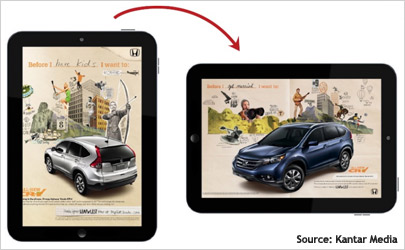
With Conde Nast, Hearst and Meredith launching their own digital newsstand in the form of Next Issue Media, it’s clear that magazine publishers are
counting on tablets for future growth.
Forecasts predicting rapid tablet adoption abound. eMarketer, for instance, projects that U.S. tablet penetration will increase from 10.8% in 2011 to
27.7% in 2014. Separate findings from Gfk MRI show that nearly three-quarters
of tablet owners (71%) are interested in reading magazines on their device.
But a new report from Kantar Media suggests publishers will need to
upgrade ad offerings in tablet editions to fully exploit the new platform.
The Kantar study looked at 150 top magazines, of which 110 had an iPad app and 65 had versions specifically designed
for it with exclusive digital content. That sample also included 42 magazines with versions tailored to the iPhone, a news feed format, the Zinio Magazine Reader or a separate news reader app.
Among magazines with iPad editions, more than 90% of advertisers also ran ads in the corresponding print ones. Established advertisers are migrating to tablets, serving as the test bed for initial
ad experiments. Regardless of what deals were cut, Kantar credits publishers for continuing to build relations with brands by extending them to tablets.
At the same time, however, iPad titles
carried far fewer ads than their print counterparts. The average ratio was about 60%, but ranged from less than 10% to more than 150%. Given that magazine apps are still at an early testing stage, the
study reasoned it was too soon to conclude that the lighter ad load in tablets will remain a constant feature.
Conspicuously absent from iPad editions were pharmaceutical ads -- a mainstay of
print magazine ad pages. Kantar attributed the absence of prescription drug advertising to the stricter requirements that pharma advertisers face online to provide detailed disclosures about their
products.
A wider problem -- and one publishers and advertisers have more control over -- is the lack of ad creative that harnesses the full interactive capabilities of the medium. “In
general, most magazine tablet ads were repurposed print creatives without elaborate animations or advanced interactive features, other than links to the advertisers’ Web site or social media
pages like Facebook, Twitter and LinkedIn,” stated the report.
The study found, for example, that less than half of iPad titles provided both portrait and landscape orientation for ads.
One exception was a Honda CR-V ad in which the headline, background artwork and product shot all changed when the iPad was rotated from portrait to landscape view.
Auto advertisers were the
most likely to leverage rich media functions in ads. Another was a Scion ad appearing in Wired allowing readers to access image galleries, video and animation as well as the ability to lift,
rotate or shake the iPad to interact with an ad.
Ads with deep interactive elements tended to appear mainly in publications like Wired or Popular Science, aimed at a more
tech-savvy audience. Those two were also among the first titles to launch iPad editions when Apple introduced the device two years ago.
The study similarly identified a handful of ads that
contained overlays to view additional product information. A Converse ad, for instance, had two calls to action: one tap for details on its clothing line, and another that took users to a
Bloomingdale’s shopping page.
If more dynamic ads like Converse’s were few, house ads turned up often. They typically cross-promoted another app by the same magazine brand or
publisher. The abundance of house ads also underscored the relative dearth of third-party ads in iPad titles.